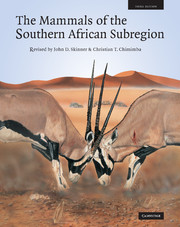Book contents
- Frontmatter
- Contents
- Editorial board
- Acknowledgements
- Foreword
- Preface
- The Mammal Research Institute
- R. H. N. Smithers
- Explanatory notes
- SUPERCOHORT AFROTHERIA
- COHORT PAENUNGULATA
- SUPERCOHORT EUARCHONTAGLIRES COHORT GLIRES
- Order LAGOMORPHA
- Order RODENTIA
- Suborder HYSTRICOGNATHI
- COHORT EUARCHONTA
- SUPERCOHORT LAURASIATHERIA
- COHORT FERUNGULATA
- Bibliography
- Appendix 1 Conservation status of southern African mammals
- Appendix 2 Colloquial names
- Index of scientific names
- Index of English colloquial names
- List of subscribers
- Plate Section
- Plate Section
- Plate Section
- Plate Section
- Plate Section
- Plate Section
- Plate Section
Order LAGOMORPHA
from SUPERCOHORT EUARCHONTAGLIRES COHORT GLIRES
Published online by Cambridge University Press: 05 July 2013
- Frontmatter
- Contents
- Editorial board
- Acknowledgements
- Foreword
- Preface
- The Mammal Research Institute
- R. H. N. Smithers
- Explanatory notes
- SUPERCOHORT AFROTHERIA
- COHORT PAENUNGULATA
- SUPERCOHORT EUARCHONTAGLIRES COHORT GLIRES
- Order LAGOMORPHA
- Order RODENTIA
- Suborder HYSTRICOGNATHI
- COHORT EUARCHONTA
- SUPERCOHORT LAURASIATHERIA
- COHORT FERUNGULATA
- Bibliography
- Appendix 1 Conservation status of southern African mammals
- Appendix 2 Colloquial names
- Index of scientific names
- Index of English colloquial names
- List of subscribers
- Plate Section
- Plate Section
- Plate Section
- Plate Section
- Plate Section
- Plate Section
- Plate Section
Summary
THIS FAMILY HAS long been considered the sister taxon to the rodents, but the Glires concept has been challenged by Graur et al. (1996), who reported that lagomorphs are more closely related to the primates. However, Halanych (1998) reanalysed the data of Graur et al. (1996) and could find no reason to support a close lagomorphprimate association. Fossil evidence (e.g. Meng et al., 1994) fully supports a lagomorph-rodent association. A paper by Matthee & Robinson (1997b) gives further support to the Glires concept.
The family is represented in the subregion by three genera: Lepus Linnaeus, 1758, Pronolagus Lyon, 1904 and Bunolagus Thomas, 1929, and one introduced genus, Oryctolagus Lilljeborg, 1874. At the generic level the status of Bunolagus has been the subject of controversy. Originally it was described as Lepus monticularis Thomas, 1903, but generic differences between it and representatives of Lepus were later recognised (Thomas, 1929), and it was given the generic name Bunolagus. Nevertheless, Ellerman & Morrison–Scott (1951) regarded Bunolagus as a synonym of Lepus and this was accepted by Ellerman et al. (1953) and Meester et al. (1964). Angermann (1966) returned it to Bunolagus and this usage was subsequently retained by Petter (1972).
Robinson (1981a) undertook a complete revision of South African Leporidae, using not only traditional taxonomic methods but also modern techniques including univariate and multivariate morphometric analysis, karyology, sperm morphology, electrophoretic analysis of serum proteins and red blood cell enzymes.
- Type
- Chapter
- Information
- The Mammals of the Southern African Sub-region , pp. 63 - 76Publisher: Cambridge University PressPrint publication year: 2005

